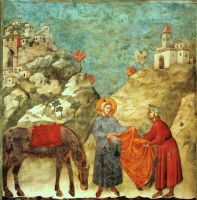Geologist, Renaissance scholar and author of "Tweeting da Vinci", Ann C. Pizzorusso explores the influence of St. Francis and Giotto on religion, art and ecology.  FOR IMMEDIATE RELEASE / PRURGENT
Geologist, Renaissance scholar and author of "Tweeting da Vinci", Ann C. Pizzorusso explores the influence of St. Francis and Giotto on religion, art and ecology.
She looks at Central Italy, which has some of the most complex geology in the world, and finds that in the midst of this inscrutable territory, two people emerged – St. Francis and Giotto – who would ultimately change the history of ecology, religion and art by extolling the landscapes and geology of this region.
From antiquity to the Middle Ages, humans had a conflicting
relationship with nature, seeing it as representing either
divine or satanic forces. On the vanguard of a change in perspective
toward the natural world was St. Francis of Assisi
(ca. 1181–1226) who is now, thanks to his pioneering work,
a patron of ecology. He set forth the revolutionary philosophy
that the Earth and all living creatures should be respected as
creations of the Almighty.
St. Francis’ affinity for the environment influenced the
15 artist Giotto (ca. 1270–1337), who revolutionized art history
by including natural elements in his religious works. By taking
sacred images away from heaven and placing them in
an earthly landscape, he separated them definitively from
their abstract, unapproachable representation in Byzantine
art. Giotto’s works are distinctive because they portray daily
life as blessed, thus demonstrating that the difference between
the sacred and profane is minimal.
Disseminating the new ideas of St. Francis visually was
very effective, as the general populace was illiterate. See
ing frescoes reflecting their everyday lives in landscapes
that were familiar changed their way of thinking. The trees,
plants, animals and rocky landscapes were suddenly perceived
as gifts from the Creator to be used, enjoyed and respected.
Furthermore, Giotto recognized that the variety of
dramatic landscapes would provide spectacular visual interest
in the works. By including the striking landforms of central
Italy, and portraying them accurately, Giotto allows us
the opportunity to identify the types of rock in his frescoes
and possibly even the exact locations he depicted. In fact, it
would be discoveries in the pink Scaglia Rossa limestone –
depicted in Giotto’s frescoes as pink buildings and used to
construct the Basilica of St. Francis at Assisi – which would
revolutionize the history of geology. |